Animation &Commentary &Daily post &Errol Le Cain &Richard Williams 25 Feb 2013 05:28 am
POV
Next Friday, at the invitation of filmmaker-editor-director, Kevin Schreck, I’ll have the pleasure of seeing his recently completed documentary, Persistence of Vision. This is the story of the making of Richard Williams‘ many-years-in-the -making animated feature, The Cobbler and the Thief. I’m not sure of the film maker’s POV, but I somehow expect it to be wholly supportive of the insistent vision of Richard Williams in the making of this Escher-like version of an animated feature. A work of obsession.
It’s the tale of an “artist”, someone who sees himself as an artist, and continually pushes through the world with what would seem to be evident proof of such. After all, this man had single-handedly altered the face of 2D animation in a world that was about to throw it away with all its rich history and artistry and strengths. A medium that had developed through the years of Disney with giant, filmed classics such as Snow White, Pinocchio, Fantasia and even Sleeping Beauty. A medium that had drastically changed to 20th century graphics under the hands of people like John Hubley, Chuck Jones, George Dunning and many others and had just about reached a zenith where it was moving toward something wholly new, something adult.
Instead the medium took a turn in the wrong direction. The economics of television brought us back almost 100 years as films became more and more simplistic and simpleminded in the rush to be cheap. Even the Disney studio went for the poorest subject matter using cost-saving devices to sell their films. Films became shoddier and shoddier, and the economics ruled. The closest the medium would come to art was Ralph Bakshi‘s Fritz the Cat and Heavy Traffic, low budget movies that traded on racy material in exchange for an attempt at something adult, stories barely held together with editing tape. Animation was getting a bad name from every corner whether it was the sped-up graphics of Hanna-Barbera, the reach to the lowest common denominator with poor animation from Disney, or the shock and tell of Ralph Bakshi‘s filmed attempts at what he saw as art.
Williams took a different turn. He went back to the height of animation’s golden era, inviting artists such as Grim Natwick, John Hubley, Ken Harris and Art Babbitt to his London studio to lecture on the rules and backbone of the animation. He brought some of these people to work on a feature that he’d decided to create within his studio on the profits of commercials. These very same commercials financed the training of Dick and his young staff.
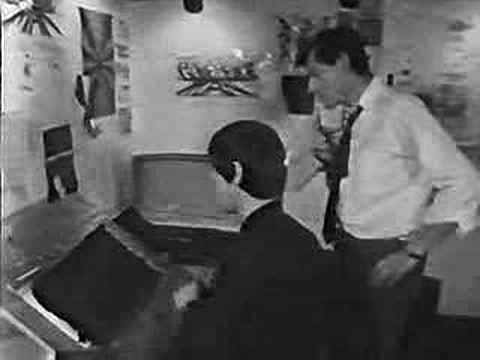 A documentary done in 1966, called The Creative Person: Richard Williams offers an excellent view of his studio. We see snippets of shorts Dick made with his own coin: Love Me Love Me Love Me (1962) or The Sailor and the Devil (1967) wherein we see the training of a young and brilliant illustrator named Errol le Cain. (Le Cain became known for his magnificent, glimmering children’s book illustrations. He was doing most of the backgrounds for The Cobbler and the Thief, and had certainly had a large part in its design.)
A documentary done in 1966, called The Creative Person: Richard Williams offers an excellent view of his studio. We see snippets of shorts Dick made with his own coin: Love Me Love Me Love Me (1962) or The Sailor and the Devil (1967) wherein we see the training of a young and brilliant illustrator named Errol le Cain. (Le Cain became known for his magnificent, glimmering children’s book illustrations. He was doing most of the backgrounds for The Cobbler and the Thief, and had certainly had a large part in its design.)
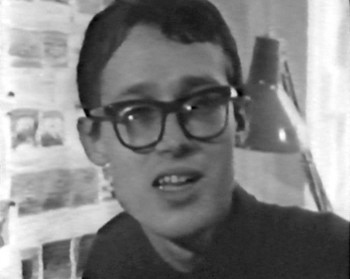 We see in this documentary the first hint of The Cobbler when it was called Nasruddin. It was based on a book of middle eastern tales of a wise fool whose every short story tells a new and positive anecdote. Dick had illustrated several books of these tales with many funny line drawings. The book was written by the Idres Shah who had undertaken a role within the Willams studio finding funds for the feature. Eventually, the two had a falling out, and Idres Shah left with his property. Williams took the work he had done as Nasruddin and reworked it into The Cobbler and the Thief. ________________________________Errol le Cain
We see in this documentary the first hint of The Cobbler when it was called Nasruddin. It was based on a book of middle eastern tales of a wise fool whose every short story tells a new and positive anecdote. Dick had illustrated several books of these tales with many funny line drawings. The book was written by the Idres Shah who had undertaken a role within the Willams studio finding funds for the feature. Eventually, the two had a falling out, and Idres Shah left with his property. Williams took the work he had done as Nasruddin and reworked it into The Cobbler and the Thief. ________________________________Errol le Cain
Meanwhile the work within his studio continued to develop, growing more and more mature. The commercials became the highlight of the world’s animation. Doing many feature film titles such as What’s New Pussycat (1965), A Funny Thing Happened on the Way to the Forum (1966), The Charge of the Light Brigade (1968) led to Dick’s directing a half-hour adaptation of The Christmas Carol (1971). Chuck Jones produced the ABC program, and it led to an Oscar as Best Animated Short.
Through all this The Cobbler and the Thief continued. Many screenplays changed the story and the stunning graphics that were being produced for that film were often shifted about to accommodate the new story.
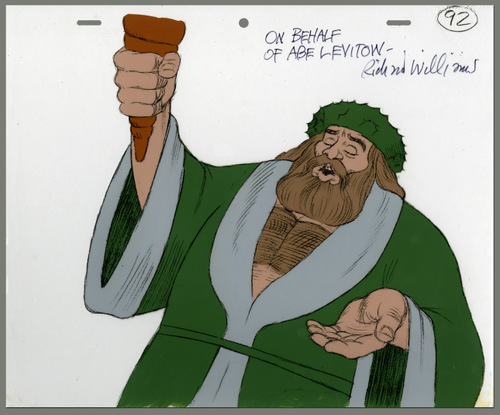 By this time, Williams had developed something of a name within the world of animation. Strong and important animation figures went to his studio to work for periods of time. Someone like Abe Levitow taught and animated for the studio. (His scenes for The Christmas Carol are among the most powerful.) Many of the Brits that worked in the studio and then left to start their own companies were now among the world’s best animators.
By this time, Williams had developed something of a name within the world of animation. Strong and important animation figures went to his studio to work for periods of time. Someone like Abe Levitow taught and animated for the studio. (His scenes for The Christmas Carol are among the most powerful.) Many of the Brits that worked in the studio and then left to start their own companies were now among the world’s best animators.
Williams had the opportunity of doing a theatrical feature adaptation of the children’s books The Adventures of Raggedy Ann and Andy and took it. A large staff of classically trained animation leaders such as Art Babbitt, Grim Natwick, Tissa David, Hal Ambro, Emery Hawkins and many others worked out of New York or LA as the company set up two studios to produce this film. Working for over two years, Dick’s attention was diverted to work away from his London studio, where commercials and some small devotion was given to The Thief by a few of the key personnel working there. Dick spent a good amount of his time in the air flying from NY to LA to NY to London and back again and again. He concentrated his animation efforts on cleaning up animation by some of the masters, rather than allow proper assistants to do these tasks. By doing this he was able to reanimate some of the work he didn’t wholly approve of. Entire song numbers were reworked by Dick as the film flew well behind its budget and schedule.
Eventually, the film finished in confusion and mismanagement, and Dick moved to his LA studio where he continued commercials and began Ziggy’s Gift, a Christmas Special for ABC.
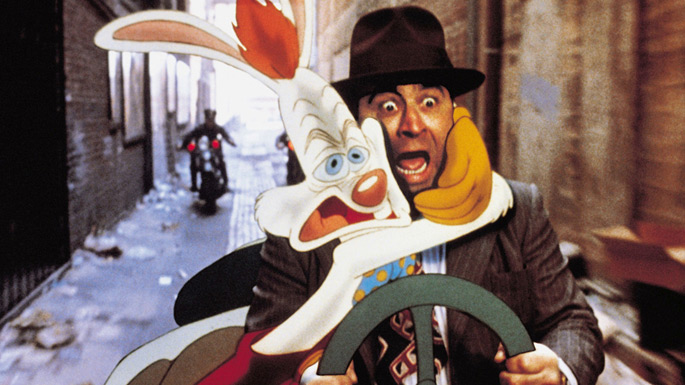 From this he went back to his London studio and did the animation for Who Framed Roger Rabbit for producer/director Robert Zemeckis. He hoped that work on this feature, which won three Academy Awards, including a special one for the animation, would be the triumph he needed to help him raise the funds for The Thief and the Cobbler. Now that he was safely back in his own studio in Soho Square he felt more focused.
From this he went back to his London studio and did the animation for Who Framed Roger Rabbit for producer/director Robert Zemeckis. He hoped that work on this feature, which won three Academy Awards, including a special one for the animation, would be the triumph he needed to help him raise the funds for The Thief and the Cobbler. Now that he was safely back in his own studio in Soho Square he felt more focused.
A contract came from Warner Bros., and the work began in earnest.
Dick’s history wasn’t the best working on these long form films. Chuck Jones replaced him on The Christmas Carol to get it finished when work went overbudget and schedule. Dick was putting too much into it. Gerry Potterton finished Raggedy Ann when the budget went millions over with less than a third completed. Eric Goldberg took over Ziggy’s Gift, the Christmas Special for ABC, to get it done on time. On Roger Rabbit, the live action director stayed intimately involved in the animation after his shoot was complete. When it became obvious that things weren’t going well, he stepped in to complete that film.
In all cases of all of these films, Dick never left. He stayed on working separately on animation or assisting to try to keep a positive hand in the quality of the work that was done.
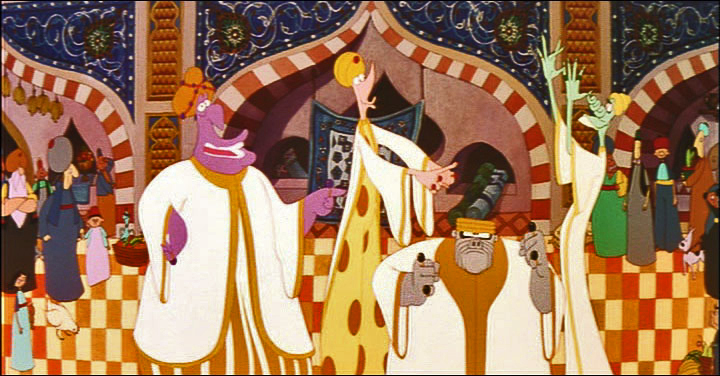 When The Cobbler and the Thief ran into very serious trouble, there was no secondary Director or Producer to come in and complete the work. Instead that job fell to the money men. The completion bond company, essentially an insurance company for Warner Bros. to make sure they wouldn’t lose their money if things didn’t go well, stepped in. They closed Dick’s studio and removed Dick from the premises. The boxed up and carted off all animation work done or in progress. It was all moved back to Los Angeles.
When The Cobbler and the Thief ran into very serious trouble, there was no secondary Director or Producer to come in and complete the work. Instead that job fell to the money men. The completion bond company, essentially an insurance company for Warner Bros. to make sure they wouldn’t lose their money if things didn’t go well, stepped in. They closed Dick’s studio and removed Dick from the premises. The boxed up and carted off all animation work done or in progress. It was all moved back to Los Angeles.
The Weinsteins, through their company, Miramax bought the film at auction and completed it with a poor excuse of an animation outfit they set up in LA. Work was also sent to Taiwan. The script was reworked trying to capitalize on the success of Disney’s Aladdin that had recently opened in the US. If Robin Williams‘ ad libbing could be such a success, imagine how well Jonathan Winters could do repeating that for a character who, in Dick’s original version, had no voice. Now he didn’t stop talking.
The new film failed miserably and deserved to do so. The primary audience, I would suspect, was the entire world animation community coming to look down on the artificially breathing corpse.
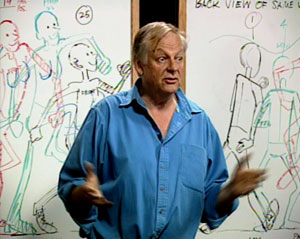 Richard Williams, himself, retired and moved far from the mainstream. He continues to work on small animation bits, but his primary work has been in making a series of DVD lectures revealing how animation should be done. This accompanies a well-received book he wrote and illustrated. Meanwhile, the animation community still hopes that something will emerge from that corner.
Richard Williams, himself, retired and moved far from the mainstream. He continues to work on small animation bits, but his primary work has been in making a series of DVD lectures revealing how animation should be done. This accompanies a well-received book he wrote and illustrated. Meanwhile, the animation community still hopes that something will emerge from that corner.
Dick turns 80 years old on March 19th. He’s still an amazing forceful and exciting personality. I wish I had more access to him (as does most of those who knew him back then.) He’s had probably the greatest effect on the animation industry of anyone since the late sixties. There are still studios thriving today on information they learned from Dick and his teaching.
If you’re unfamiliar with the blog, The Thief, I suggest you take a look.


on 25 Feb 2013 at 6:55 am 1.Nat said …
Very interesting. I wrote a similar post about Williams and his film a while ago on my blog as well.
on 25 Feb 2013 at 10:51 am 2.Richard O'Connor said …
Great line: “The primary audience, I would suspect, was the entire world animation community coming to look down on the artificially breathing corpse.”
I may miss the Thursday screening -the one I really want to see -due to prior commitments but hope to see you Friday.
on 25 Feb 2013 at 12:05 pm 3.Scott said …
If Dick had been more interested in story and storytelling –and character–than technique alone, he probably wouldn’t have caused his film to be finished by others.
on 25 Feb 2013 at 7:03 pm 4.Mark Kausler said …
Hey Michael,
Credit where credit is due, Fred Calvert’s studio “finished” THE THIEF AND THE COBBLER and released it as “ARABIAN KNIGHT”.
Mark Kausler
on 25 Feb 2013 at 8:09 pm 5.Andrew said …
Great writing about Dick Williams and his troubled opus.
So how do you regard Don Bluth, the animator who for a brief time actually outperformed Disney’s films?
Many people who grew up in the 1980s seem to have a kind of fondness for his films like Secret of Nimh, Land Before Time, and An American Tail. I have read that his films, along with Dick Williams, helped motivate Disney to make better films, resulting in the all-too-brief renaissance of the 1990s.
on 26 Feb 2013 at 10:09 am 6.Luke said …
Dick Williams had nothing to do with Disney Feature animation resurgence. And the only thing bluth had to do with it was leaving, which everyone was grateful for. He was holding back the new talent who had more to say. and better stories to tell,than he did.
on 26 Feb 2013 at 10:29 am 7.Michael said …
Your view of the world of animation is sharply narrow and unfocused. Eric Goldberg, himself, was a product of the Williams studio. Any influence he, alone, brought to Disney came from Williams. Beauty and the Beast was originally started by Richard Purdum, Dick’s right hand man. Purdum left because he was creating a non-musical version and was more serious than the new management wanted.
ALL OF ANIMATION was affected by Williams who brought a Renaissance to the way characters moved (all on ones all the time, for example) while the old guard (Thomas, Kahl, Johnston, et al) were pushed out by the new who were all affected by the Williams world.
It goes much deeper, but I’m not here to lectuire you on things you obviously are oblivious to.
on 26 Feb 2013 at 12:35 pm 8.anik said …
I really enjoyed the Escher-esque sequences in the Thief and many other things. In my view the story doesn’t always need to be the main preoccupation in any animated film, there should be different kinds of films. The film was destroyed exactly with this “story-saving” attitude in mind. Unfortunately, this approach may be what is needed for a successful return of investment.
on 26 Feb 2013 at 11:35 pm 9.Scott said …
But it was destroyed by Williams himself, by not willing to complete the film on the budget and schedule he agreed to. If he had finished the film as he’d wished that way, it would have still bombed at the box office, but as a “mammoth ego trip (as Williams’ himself once called it)” I’d rather the world have that.
on 27 Feb 2013 at 10:14 am 10.Luke said …
Some artists were influenced by working with him, but the studio itself wasn’t so much so “motivated” by this.. Notice they chose to go with a more popular take on Beauty and the Beast, to great box office advantage. All of this was after the success of Little Mermaid. And I’d say there’s a stronger argument the exodus of artists like Jerry Rees, John Lasseter, Tim Burton, Brad Bird and the projects they begat really drove Disney’s revival as much–and likely more so–than Williams or bluth fleeing.
on 27 Feb 2013 at 10:23 am 11.Michael said …
I didn’t say that Williams in any way “drove the revival” fo Disney animation. But had it not been for Williams, there would not have been so strong a move toward good animation. This newly burgeoning air of excellent artistry in animation – which was driven by Williams – helped move Bluth and his people out of Disney as much as anything. They, too, wanted to do “something good again.”
Nothing in history is based on one event, everything drives from everything else. Williams threw an air into the medium, and inspired artists; everyone wanted to do better work.
on 27 Feb 2013 at 11:57 am 12.anik said …
Yes Scott, you are probably right about this case, my comment was not really about the production issues, but about the type of film it was going to be. Williams’s management skills may have been a mess, but he brought unique creative vision, which rarely happens with more “responsible” features, so he deserves a credit for that. That his vision maybe wouldn’t be very box office friendly – probably, but that doesn’t necessarily discredit it in my view.
on 27 Feb 2013 at 3:58 pm 13.Luke Menichelli said …
For the sake of keeping events and dates clear:
The Animator Who Never Gave Up
by Edward Summer in “Films in Review” Nov-Dec 1995
June 1992
Williams shows what he has of The Thief in Los Angeles. All but about 15 minutes of film is finished.
Clutching stacks of red-inked balance sheets, The Completion Bond Company fires everyone including Williams.
Fred Calvert, an animator/producer, with a strong background in television animation is brought in to complete the project once and for all.
September 1992
Williams assembles a kind of work print (much like the “Work-in-progress” version of Beauty and the Beast which was shown at the New York Film Festival) and turns it over to Calvert.
Summer 1993
Calvert is actually finishing the film with the help of several other studios including Don Bluth’s which is called in to work on some songs which have been added to “flesh out” the story which has been shortened by compression of scenes and the elimination of some completed animation.
Early 1994
The Princess and the Cobbler is released in Australia and South Africa. It does not break any boxoffice records….
January 1995
Miramax buys the film from The Completion Bond Company, which subsequently goes out of business.
Originally intending to release the Calvert version, someone gets “cold feet” and decides to rework the film in order to improve its box office performance.
A wall-to-wall dialog track is added, the order of events is changed, one character (the witch) is removed completely, and the film is shortened considerably.
August 1995
So many weeks behind schedule that the publicity department at Miramax doesn’t have a print to screen until opening day, Arabian Knight is released to mixed reviews and tepid boxoffice.
Luke Menichelli:
What this account doesn’t state:
Calvert destroyed the identity of the film by stripping out the classical score by Rimsky-Korsakov and others, and adding his scenes with pop songs. He removed voices and added his own. He systematically wrecked it’s structure.
Calvert dropped an entire scene rather than finish a few shots of the Princess yawning (Thief in the Princess’ bedroom). Is there a reason to cut out the middle of a pan shot to save a fraction of a second? Will it help to maximize screenings of a film that was delivered edited to a standard 90 minutes? Calvert did it. He made cuts to completed footage to satisfy either his own taste, or the Completion Bond rep pulling his strings.
Existing scripts (numbered scene by scene) that date from the seventies, revised again in the eighties, show only minor changes (primarily deletions) over time. Together with the existing, matching, dated, numbered footage, (camera tests recovered by Garrett Gilchrist), completed on time, they totally refute the repeated allegation that Richard Williams did not
know how scenes would all fit together in the end.
Once the workprint passed to other hands, it was possible to complete it in a sane, if more limited fashion. Garret Gilchrist is proving it.
Was Calvert forced into this situation?
Ostensibly sent by Completion Bond (now defunct) to check on Williams’ progress, Fred Calvert offered his own bid on completing it. How is that anything less than a conflict of interest? The competing bidder gets a big fat lucrative job, only if he declares the project’s situation hopeless. And then takes it as his own.
When Miramax started work on their edit, they didn’t go back to the Williams’ workprint. They began with Fred Calvert’s film and took out approximately another 15 minutes.
Read “Lawrence of Arabia” by L. Robert Morris to learn how, over the years, preparing it for another re-release, each pair of hands that touched that 4-hour feature, decided it was too long, trimmed a little more out of it (“There! now it’s perfect”) until it was reduced to two hours. Only the first editor started with the original length. Subsequent editors each began withe previous editor’s cut. They never considered what had come before and made their decision based on their egos (“I did that!”).
However you feel about Richard Williams style, none of the above is rational or justified.
on 03 Mar 2013 at 9:24 pm 14.David Rickert said …
Is there a place I can get my hands on this documentary? I can’t find it anywhere.
on 03 Mar 2013 at 11:43 pm 15.Michael said …
It’s just been finished and will probably never be a DVD. The cost of rights would be too prohibitive for the film maker. Look for it showing at a film festival near you.
on 07 Mar 2013 at 12:48 am 16.Animation institute said …
Thanks for sharing nice information.